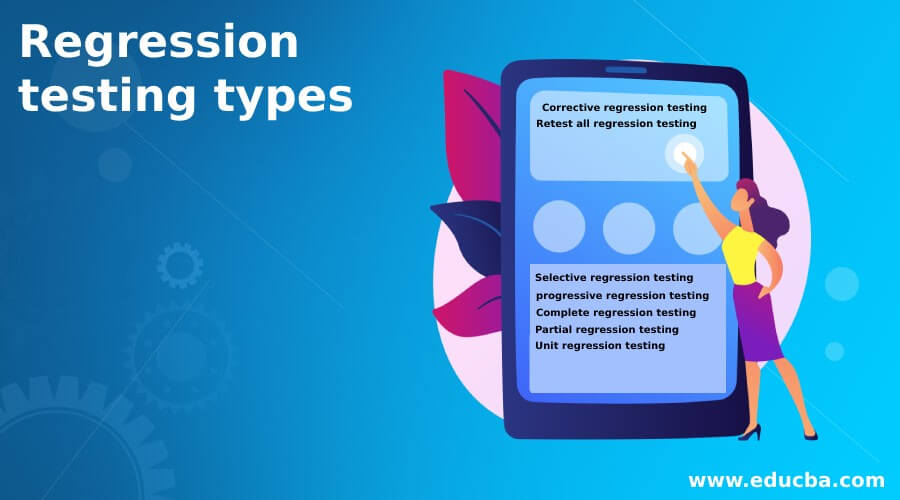Updated March 4, 2023
Introduction to Regression testing types
Regression testing is used to determine that a recent program or code change has not adversely affected the existing features. In other words, we can say that regression testing is a full or partial selection of already executed test cases that are re-executed to ensure existing functionalities work fine. Thus, it saves both time and money for the organization. As per the study, regression testing saves up to 60% of the time in bug fixes and 40% in the money. Regression testing is categorized into various types: Corrective regression testing, Retest all regression testing, Selective regression testing, Progressive regression testing, Complete regression testing, Partial regression testing, and unit regression testing.
Types of regression testing
Here are the following types of regression mention below
1. Corrective regression testing
Corrective regression testing is used when there are no changes introduced in the existing system. Existing test cases can be used to conduct the desired test. Corrective regression testing takes less time to find the bugs. Because of its repetitive use and convenience, most developers make use of this testing.
2. Retest all regression testing
Retest all regression testing is used to test all the test cases again. Therefore, all test cases should be retested. Retest all Regression testing is very expensive as it requires more effort and resources. When the developer tests the case and fails, the developer determines the cause of the failure, i.e., software fault, and adds a tag as a retest. Then developer reports the software fault and expects the new version of the software where the fault gets fixed. In this case, a developer needs to execute test cases again to ensure that the fault is solved. This process is called as Retest regression testing.
3. Selective regression testing
In selective regression testing, only selected test cases are tested where changes in the code occur. It does not test the complete test case. Based on the requirements, new code is written and replaced with old ones. Selective regression testing makes it possible to test and comprehend the outcomes of the original code. It checks the effect of both old code and new code in the same environment and time. It includes variables, functions and other components in the system whenever changes occur in the system. This process does not affect the other part of the code and other core areas. Because of these benefits, selective regression testing is most commonly used to execute the test cases.
4. progressive regression testing
Progressive regression testing is a more complex process. It is used when few changes are done in the system. Then, based on the requirement, new test scenarios are created. It allows the testing team to conduct the required step within the updated version of the program without affecting the current features of the system.
5. Complete regression testing
Complete regression testing is used when an organization does not want to make any big changes in the system during testing, but current code undergoes lots of changes in the system. It examines the current code and features before running any test cases. Complete regression testing allows the developer to restore any changes that may be done during the process. Because of its features to find the bugs quickly, it is the most common choice for the organization. It is known as a promising test.
6. Partial regression testing
Partial regression testing is used whenever the new code is added to the current code; the tester executes the partial regression testing instead of other testing. Partial regression testing tests the specific part of the system that may be affected by any changes in the system. It is used to add code parts to the system for a specific reason. It enables the tester to detect the bugs in the current code easily. It performs an important role on a tiny part. It also helps the tester to test the current code without harming other parts of the code in the system. It saves lots of time and money if conducted at the right time.
7. Unit regression testing
Unit regression testing is used whenever changes occur in the unit or component of the system. When changes are done in the unit or component, the tester again runs the previous test cases to test that component. As it focuses on the code of the single unit, it is conducted in the isolations. I.e., while performing testing, the tester blocks all the dependencies and interactions. Then the result of this test is evaluated to identify whether testing was conducted on the system or not. Thus, the experienced tester conducts unit regression testing.
Recommended Articles
This is a guide to Regression testing types. Here we discuss the various types of regression testing such as Corrective regression testing, Retest all regression testing, Selective regression testing, Progressive regression testing, Complete regression testing, Partial regression testing, and unit regression testing. You may also look at the following articles to learn more –


